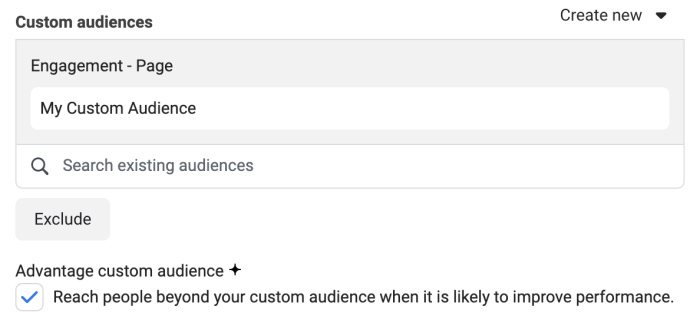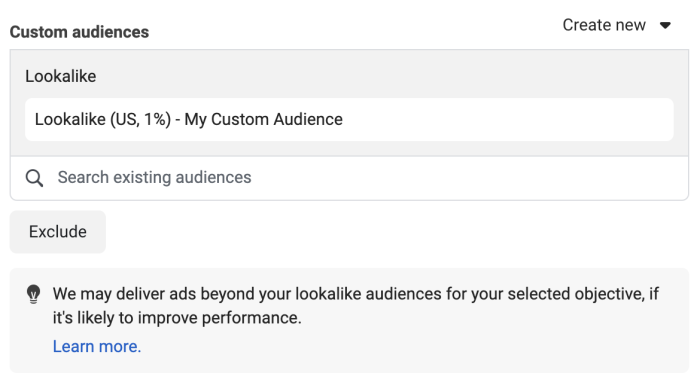Facebook is rolling out Advantage Custom Audiences to advertisers, which will potentially expand your targeting when a custom audience is selected.
Wait… This isn’t new, right? Oh, it is?
You’d be forgiven if this sounds like something that’s already been around for a while. A couple of similar audience expansion features have been rolled out to the Advantage product line during the past year. But this, indeed, is new.
Let’s break down what this is, how it’s applied, when you’d use it, and when you absolutely should avoid it.
What Is This?
First, let me be clear that this is a rollout. I don’t have it in most of my accounts.
But, if you enter a custom audience into targeting and you see a checkbox for Advantage Custom Audience like the image below, congrats. You have it.

When Advantage Custom Audience is turned on, your custom audience will be targeted, but targeting can be expanded to people outside of that custom audience if it can improve performance.
Sound familiar? Yeah, that’s a lot like Advantage Detailed Targeting (formerly Detailed Targeting Expansion)…

and Advantage Lookalikes (formerly Lookalike Expansion).

In both cases, the audience can be expanded beyond what you enter if it can improve performance. But, of course, those features were unique to Detailed Targeting and Lookalike Audiences.
When Is It On?
How and when Advantage Custom Audiences are turned on are a bit different than for Advantage Detailed Targeting and Advantage Lookalikes. You can turn Advantage Custom Audiences on, no matter the objective. The other two are objective-specific.
Another difference is that even if Advantage Custom Audience is turned on by default (it will be), you can turn it off. Originally, this was the case with Advantage Detailed Targeting and Advantage Lookalikes. But now, you are unable to turn those two options off (at least in most cases).
Once you enter a custom audience, you can turn this on (assuming you have the feature), regardless of the objective.
When Should You Use It?
Admittedly, I’ve been a bit skeptical of the other two audience expansion products. I’ll get to that more in a moment. But, there is actually a good reason to use Advantage Custom Audiences.
Far too many advertisers struggle with understanding how to set budgets when targeting custom audiences. In almost all cases (unless you’re a big brand), these audiences are going to be small. It doesn’t matter whether it’s website visitors, page engagement, or your email list. We’re usually talking about a few thousand people — or at least under 100,000.
If you treat these audiences the way you do broad targeting and throw a $100 per day budget on it, you’re going to torch that audience pretty quickly. The frequency and CPM will also jump.
Assuming that your messaging isn’t unique to the audience you’re targeting (more on that in a moment), expanding the audience would make a lot of sense.
It’s important to understand how this works. The audience doesn’t immediately jump from 5,000 to 5,000,000 (even if the “potential” audience may look that way). The audience will only expand if it will improve results. The custom audience will still be the core audience used for targeting.
So, expanding your audience could actually improve your average frequency and CPM. Your audience is used in a similar way to how it’s used to generate a lookalike audience. But in this case, that source audience is still used for targeting.
When You Definitely Shouldn’t Use This
When I first heard that this feature was being tested, I was concerned. Audience expansion makes very little sense to much of our remarketing.
Consider the abandoned cart scenario. In that case, you are targeting people who added a specific product to their cart and didn’t purchase. You may create an ad that says something like, “Hey, did you forget something?” and showcase that product. This ad, of course, would only make sense for those in a specific audience.
The same would apply for cross promotions and up-sells. In either case, the ad copy may refer to something specific that a customer did or bought that’s related to another product. This would make no sense to an expanded audience.
In other words, be extra careful with your remarketing. If the ad copy and creative will only make sense to your targeted audience, make sure to turn off Advantage Custom Audience.
Transparency, blah, blah, blah…
If you’ve listened to my podcasts or are in the PHC community, you’re probably tired of hearing me talk about this by now. But I’m not going to stop until this is fixed.
Audience Expansion is a fine little feature if it’s effective. The problem is that we have very little evidence to prove this. It’s not that it’s not working. We just don’t know because it’s all left behind the curtain.
First, we don’t even know if the audience is expanded when this is turned on. Yes, in theory, it can be expanded when any of these features is turned on. We never know when the audience is expanded, how much it’s expanded, or how many of your results came due to expansion.
And that would be helpful, right? Give me a breakdown showing performance of my targeted audience compared to the expanded audience. This could then sell the feature, underscoring the benefit.
This doesn’t exist. You can split test two ad sets when expansion is on and when it’s off. But that’s the closest we get to fully understanding whether this feature is worthwhile. Beyond that, it’s all a guess.
Watch Video
Your Turn
Do you have Advantage Custom Audiences? What do you think, will you use it?
Let me know in the comments below!






